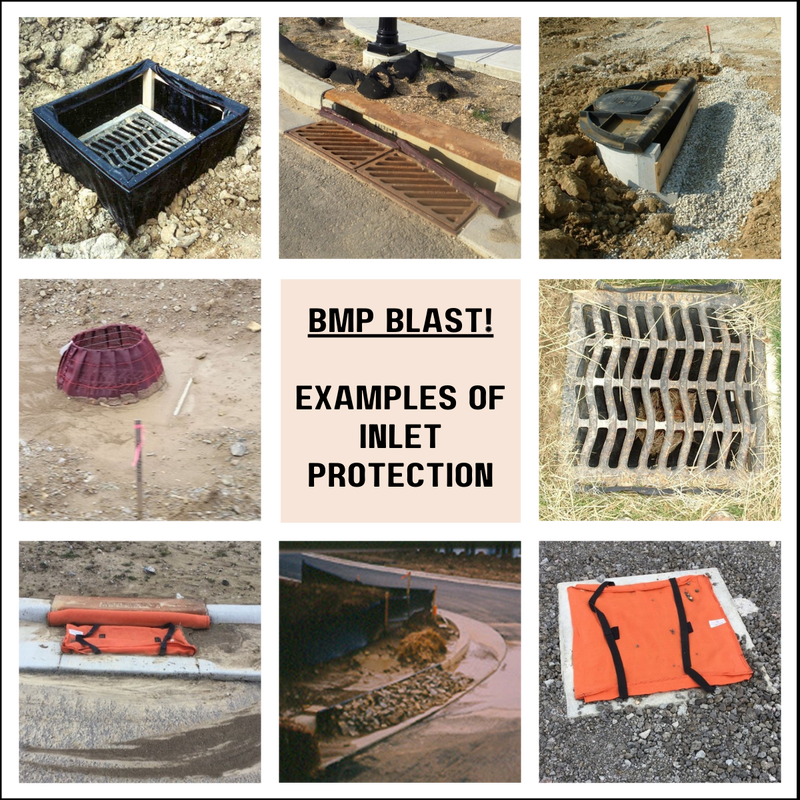|
BMP Blasts are issued every three months to highlight a sediment and erosion control best management practice. These blasts are designed to provide helpful insight and tips for properly designing, installing, using, and maintaining the control measure. Where and why is inlet protection required? Inlet protection is required on any storm drain at risk of receiving construction site run off. That said, there are limitations to the power of inlet protection. These controls are only designed to manage sediment from a drainage area of one acre or less. If greater than 1 acre of land is draining to one inlet, additional practices such as sediment traps or basins may be required. You may be thinking, “but, I have silt fence and a basin with a skimmer already!” Unfortunately, no one practice is 100% effective when it comes to sediment removal; they each have different strengths and weaknesses. For example, inlet protection has a limited ability to remove silts and clays but can effectively capture larger sand-size particles. The combined effect of each BMP helps to provide maximum sediment removal from storm flows prior to off-site discharge. In other words- perimeter controls, inlet protection, and a basin with a skimmer are likely all required (depending on the site and area of disturbance). Should I have inlet protection listed on my SWPPP? Yes! Inlet protection must be shown on the stormwater pollution prevention plan. While most contractors are familiar with the need for inlet protection, it is important that this is noted on plans to ensure any operator on-site is aware of the requirements and a proper maintenance schedule can be in place. The plan will also show the location all of these “at-risk” inlets so that protection gets installed on all drains and inspectors on-site can identify the location of these areas. Furthermore, it is important to show where these practices will be located in the plan review process to ensure that the drainage area is sized appropriately for the practice. There are certain considerations for placement as well. For example, practices that operate by blocking water from entering storm drains almost completely prevents sediment-laden discharges to entering the conveyance system, but they often result in ponding water. This ponding may be important to consider if these practices will be used on roadways that could flood during heavy rainfall. Are there different types of inlet protection? There are various methods of inlet protection specified in Chapter 6 of the Ohio Rainwater and Land Development Manual. Each method utilizes a combination of stone, wire mesh, and/or geotextile to filter sediment. Alternatively, pre-manufactured inlet protection devices may be used (and reused for the lifetime of the product). What kind of maintenance do inlet filters require?
Additional Resources OEPA Rainwater and Land Development Manual United States EPA Storm Drain Inlet Protection Fact Sheet Ohio EPA NPDES General Construction Permit (OHC000006)
2 Comments
|
Details
Urban team BLOGEvery month, the Warren Co SWCD Urban Team dives deep into the world of land development as it relates to stormwater pollution prevention. The blog covers topics like erosion & sediment control best management practices (BMPs), state and local regulations, retention/detention basins, and the conservation of our natural resources. Stay up to date with Development Digest by signing up for WCSWCD Urban eNews!
Categories
All
Archives
July 2024
|
|
|
Contact:PHONE: (513) 695 - 1337
EMAIL: [email protected] HOURS: Monday - Friday 7:30am - 4:00pm (except holidays) Connect:Warren County Soil & Water Conservation District Copyright © 2016
Warren SWCD Privacy Notice. Emails are serviced by Constant Contact. Constant Contact's Privacy Notice. |



 RSS Feed
RSS Feed
